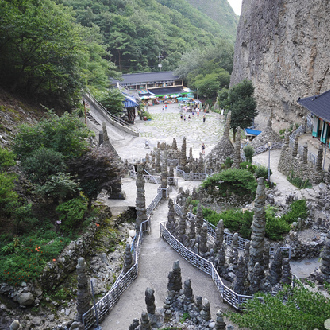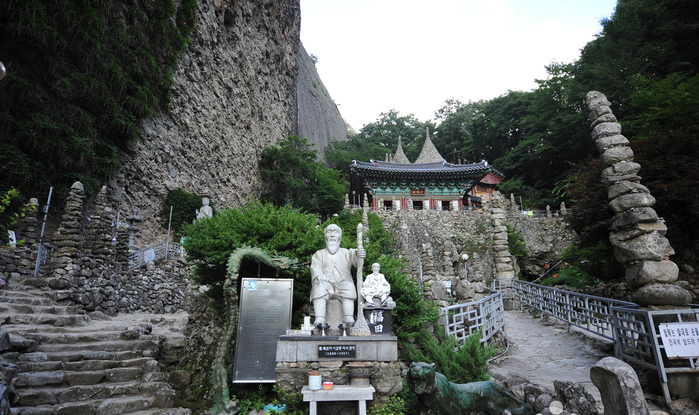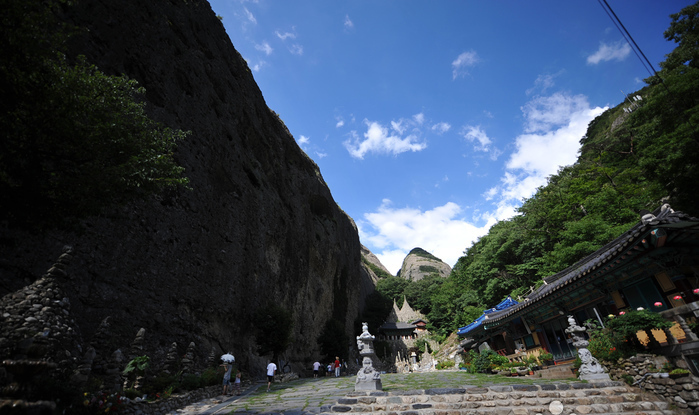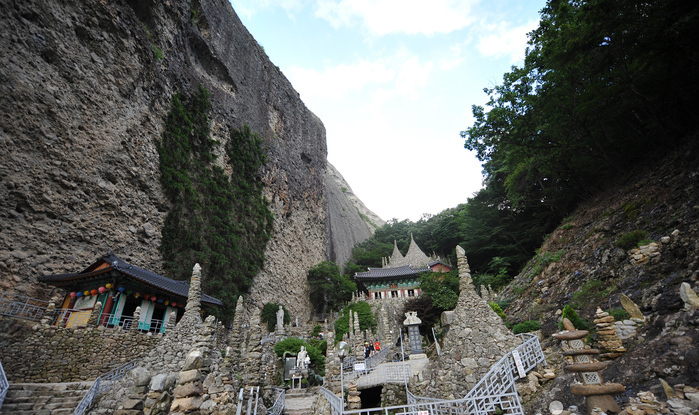Introduction:
Directions 1) From Seoul Central City Bus Terminal, take an express bus to Jinan.* Bus Schedule: 10:00, 15:10 2) From Jeonju Intercity Bus Terminal, take an intercity bus to Jinan.* Bus Schedule: 06:05-21:05, 10-15min intervals From Jinan Bus Terminal, take a bus bound for Maisan.* Bus Schedule: 07:30, 07:50-18:00, 40min intervals (Bus bound for Maisan Tapsa: runs 3 times a day)Information Introduction Tapsa Temple is located 1.9km away from the southern parking lot of Maisan Mountain in Dongchon-ri, Maryeong-myeon, Jinan-gun, Jeollanam-do. Tapsa Temple is famous for the over 80 stone pagodas built by Lee Gapyong, a retired scholar. Those stone pagodas have different sizes and shapes from cone-shaped to straight-shaped. Behind Daeungjeon, Cheonjitap tower is located. It is the largest tower, with a height 3 times as high as the average adult’s height. How this tall tower was built is still unclear, drawing much attention from people. It is said that those stone pagodas were made in the late 1800's entirely by Lee Gapyong alone. He collected stones in daytime and built the pagodas at night. Even though the pagodas have been around for more than 100 years, they have never collapsed nor even moved through strong winds, making them truly amazing. Tapsa Temple is also well known for cherry blossoms in spring, covering an area of 1.9km from Nambu (south) parking lot of Maisan Mountain to the entrance (a 30min walk). This road is the venue for Maisan Cherry Blossom Festival as well. * Cheonjitap is comprised of two twin pagodas with heights of 13.5m and placed in the south and north directions. Cheonjitap is the main pagoda, making the other pagodas at Tapsa Temple look well-balanced. It is believed that 120 towers originally existed, but only 80 of them remain today. The two towers at the very front are named Ilgwangtap and Wolgwangtap. These groups of towers are strong enough to stand up to typhoon winds, something quite hard to believe, giving the towers a certain mystery. Also, towers are tilted slightly in both directions, showing that Lee Gapyong erected the towers with the direction of the wind in mind. Telephone +82-63-433-0012 Current Status [Maisantap] Jeollabuk-do Provincial Monument No. 35 (Desiganted on April 2, 1976) Parking Facilities Available Admission Fees Adults: 2,000 won / Group: 1,800 won Youths: 1,500 won / Group: 1,200 won Children: 1,000 won / Group: 800 won Parking Fees Cars: 2,000 won / Bus: 3,000 won Pets Not permitted
Directions 1) From Seoul Central City Bus Terminal, take an express bus to Jinan.* Bus Schedule: 10:00, 15:10 2) From Jeonju Intercity Bus Terminal, take an intercity bus to Jinan.* Bus Schedule: 06:05-21:05, 10-15min intervals From Jinan Bus Terminal, take a bus bound for Maisan.* Bus Schedule: 07:30, 07:50-18:00, 40min intervals (Bus bound for Maisan Tapsa: runs 3 times a day)
Tel:
• 1330 Travel Hotline: +82-2-1330 (Korean, English, Japanese, Chinese)
• For more info: +82-63-433-0012
Information:
Tapsa Temple is located 1.9km away from the southern parking lot of Maisan Mountain in Dongchon-ri, Maryeong-myeon, Jinan-gun, Jeollanam-do.
Tapsa Temple is famous for the over 80 stone pagodas built by Lee Gapyong, a retired scholar.
Those stone pagodas have different sizes and shapes from cone-shaped to straight-shaped.
Behind Daeungjeon, Cheonjitap tower is located.
It is the largest tower, with a height 3 times as high as the average adult’s height.
How this tall tower was built is still unclear, drawing much attention from people.
It is said that those stone pagodas were made in the late 1800's entirely by Lee Gapyong alone.
He collected stones in daytime and built the pagodas at night.
Even though the pagodas have been around for more than 100 years, they have never collapsed nor even moved through strong winds, making them truly amazing. Tapsa Temple is also well known for cherry blossoms in spring, covering an area of 1.9km from Nambu (south) parking lot of Maisan Mountain to the entrance (a 30min walk).
This road is the venue for Maisan Cherry Blossom Festival as well.
* Cheonjitap is comprised of two twin pagodas with heights of 13.5m and placed in the south and north directions.
Cheonjitap is the main pagoda, making the other pagodas at Tapsa Temple look well-balanced.
It is believed that 120 towers originally existed, but only 80 of them remain today.
The two towers at the very front are named Ilgwangtap and Wolgwangtap.
These groups of towers are strong enough to stand up to typhoon winds, something quite hard to believe, giving the towers a certain mystery.
Also, towers are tilted slightly in both directions, showing that Lee Gapyong erected the towers with the direction of the wind in mind.
Telephone: +82-63-433-0012
Current:
Status [Maisantap] Jeollabuk-do Provincial Monument No.
35 (Desiganted on April 2, 1976) Parking Facilities Available Admission Fees Adults: 2,000 won / Group: 1,800 won Youths: 1,500 won / Group: 1,200 won Children: 1,000 won / Group: 800 won Parking Fees Cars: 2,000 won / Bus: 3,000 won Pets Not permitted
Directions 1) From Seoul Central City Bus Terminal, take an express bus to Jinan.* Bus Schedule: 10:00, 15:10 2) From Jeonju Intercity Bus Terminal, take an intercity bus to Jinan.* Bus Schedule: 06:05-21:05, 10-15min intervals From Jinan Bus Terminal, take a bus bound for Maisan.* Bus Schedule: 07:30, 07:50-18:00, 40min intervals (Bus bound for Maisan Tapsa: runs 3 times a day)Information Introduction Tapsa Temple is located 1.9km away from the southern parking lot of Maisan Mountain in Dongchon-ri, Maryeong-myeon, Jinan-gun, Jeollanam-do. Tapsa Temple is famous for the over 80 stone pagodas built by Lee Gapyong, a retired scholar. Those stone pagodas have different sizes and shapes from cone-shaped to straight-shaped. Behind Daeungjeon, Cheonjitap tower is located. It is the largest tower, with a height 3 times as high as the average adult’s height. How this tall tower was built is still unclear, drawing much attention from people. It is said that those stone pagodas were made in the late 1800's entirely by Lee Gapyong alone. He collected stones in daytime and built the pagodas at night. Even though the pagodas have been around for more than 100 years, they have never collapsed nor even moved through strong winds, making them truly amazing. Tapsa Temple is also well known for cherry blossoms in spring, covering an area of 1.9km from Nambu (south) parking lot of Maisan Mountain to the entrance (a 30min walk). This road is the venue for Maisan Cherry Blossom Festival as well. * Cheonjitap is comprised of two twin pagodas with heights of 13.5m and placed in the south and north directions. Cheonjitap is the main pagoda, making the other pagodas at Tapsa Temple look well-balanced. It is believed that 120 towers originally existed, but only 80 of them remain today. The two towers at the very front are named Ilgwangtap and Wolgwangtap. These groups of towers are strong enough to stand up to typhoon winds, something quite hard to believe, giving the towers a certain mystery. Also, towers are tilted slightly in both directions, showing that Lee Gapyong erected the towers with the direction of the wind in mind. Telephone +82-63-433-0012 Current Status [Maisantap] Jeollabuk-do Provincial Monument No. 35 (Desiganted on April 2, 1976) Parking Facilities Available Admission Fees Adults: 2,000 won / Group: 1,800 won Youths: 1,500 won / Group: 1,200 won Children: 1,000 won / Group: 800 won Parking Fees Cars: 2,000 won / Bus: 3,000 won Pets Not permitted
Directions 1) From Seoul Central City Bus Terminal, take an express bus to Jinan.* Bus Schedule: 10:00, 15:10 2) From Jeonju Intercity Bus Terminal, take an intercity bus to Jinan.* Bus Schedule: 06:05-21:05, 10-15min intervals From Jinan Bus Terminal, take a bus bound for Maisan.* Bus Schedule: 07:30, 07:50-18:00, 40min intervals (Bus bound for Maisan Tapsa: runs 3 times a day)
Tel:
• 1330 Travel Hotline: +82-2-1330 (Korean, English, Japanese, Chinese)
• For more info: +82-63-433-0012
Information:
Tapsa Temple is located 1.9km away from the southern parking lot of Maisan Mountain in Dongchon-ri, Maryeong-myeon, Jinan-gun, Jeollanam-do.
Tapsa Temple is famous for the over 80 stone pagodas built by Lee Gapyong, a retired scholar.
Those stone pagodas have different sizes and shapes from cone-shaped to straight-shaped.
Behind Daeungjeon, Cheonjitap tower is located.
It is the largest tower, with a height 3 times as high as the average adult’s height.
How this tall tower was built is still unclear, drawing much attention from people.
It is said that those stone pagodas were made in the late 1800's entirely by Lee Gapyong alone.
He collected stones in daytime and built the pagodas at night.
Even though the pagodas have been around for more than 100 years, they have never collapsed nor even moved through strong winds, making them truly amazing. Tapsa Temple is also well known for cherry blossoms in spring, covering an area of 1.9km from Nambu (south) parking lot of Maisan Mountain to the entrance (a 30min walk).
This road is the venue for Maisan Cherry Blossom Festival as well.
* Cheonjitap is comprised of two twin pagodas with heights of 13.5m and placed in the south and north directions.
Cheonjitap is the main pagoda, making the other pagodas at Tapsa Temple look well-balanced.
It is believed that 120 towers originally existed, but only 80 of them remain today.
The two towers at the very front are named Ilgwangtap and Wolgwangtap.
These groups of towers are strong enough to stand up to typhoon winds, something quite hard to believe, giving the towers a certain mystery.
Also, towers are tilted slightly in both directions, showing that Lee Gapyong erected the towers with the direction of the wind in mind.
Telephone: +82-63-433-0012
Current:
Status [Maisantap] Jeollabuk-do Provincial Monument No.
35 (Desiganted on April 2, 1976) Parking Facilities Available Admission Fees Adults: 2,000 won / Group: 1,800 won Youths: 1,500 won / Group: 1,200 won Children: 1,000 won / Group: 800 won Parking Fees Cars: 2,000 won / Bus: 3,000 won Pets Not permitted
Top Things to Do in Tapsa Temple

Where is Tapsa Temple
전라북도 진안군 마령면 마이산남로 367 (마령면)












Reviews (10)